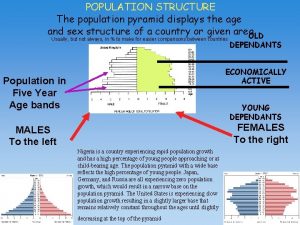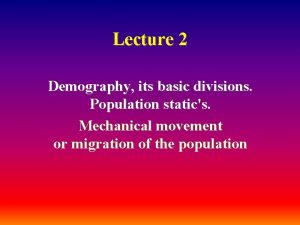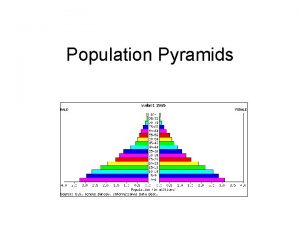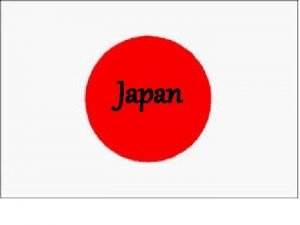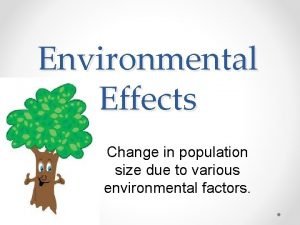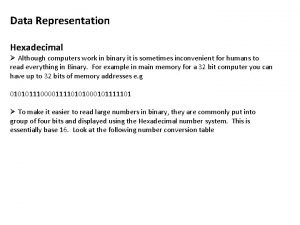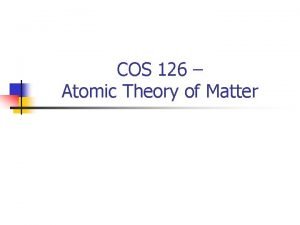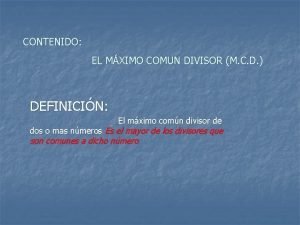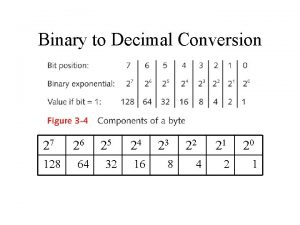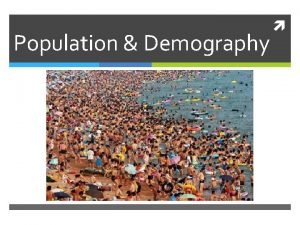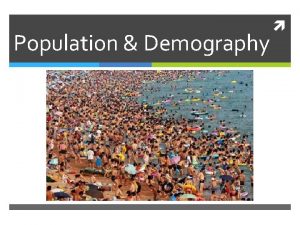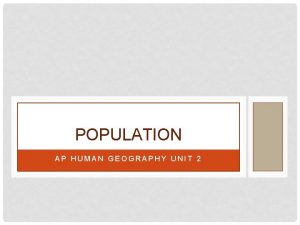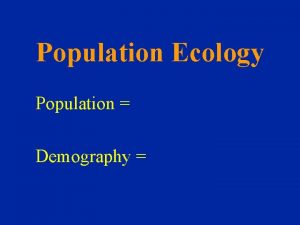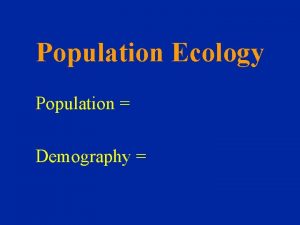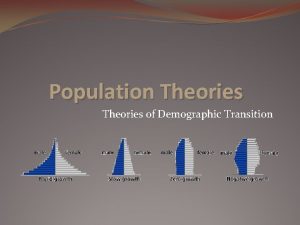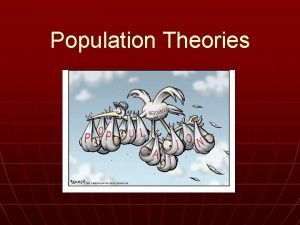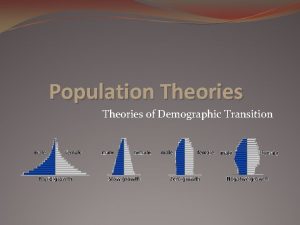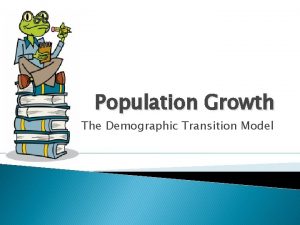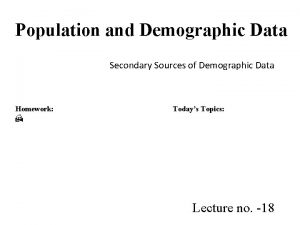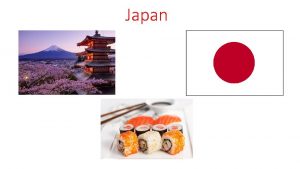Japan Demography Demographic Development in Japan population 126







































- Slides: 39

Japan


Demography & Demographic Development in Japan population 126. 442. 729

peak



What does this mean for Energy Use?


“…by 2035, the country’s population will fall by 13 percent, but the number of households will only fall by 4 percent. ”

Population Density and Transport • Cities mean less driving emissions • Rurual areas mean more driving to reach places • Per capita energy use is increasing faster in areas where population is shrinking than those where it is growing

Economic Situation of Japan

Historical Development Post WW 2 After firebombing in Tokyo 1945

Source: IEA, 2014


• Total value of exports: US$792. 9 billion • Total value of imports: US$ 856. 9 billion DEBT: 1, 1 Trillion USD

“Japan is the worlds largest liquefied natural gas importer, second-largest coal importer, and third largest net importer of crude oil and oil products” - U. S. energy information administration

Efficiency Measures Source: World Bank

Land Use Change Problem In Japan - Occurred primarily in the 1960’s and 70’s, but currently it is not super significant

CO 2 -emissions (in million kt )and GDP-growth (%) 1, 30 5 4 1, 25 2 1, 20 1 1, 15 0 -1 GDP-growth in % CO 2 -emissions in million kt 3 CO 2 emissions (kt) GDP growth (annual %) 1, 10 -2 -3 1, 05 -4 1, 00 -5 2000 2001 2002 2003 2004 2005 2006 2007 2008 2009 2010 Source: World Bank

90 Japan share of electricity generation by source (%) 80 70 60 ? 50 40 Electricity production from oil, gas and coal sources (% of total) 30 Electricity production from nuclear sources (% of total) 20 10 0 2001 2002 2003 2004 2005 2006 2007 2008 2009 2010 2011 2012 Source: World Bank



How to deal with Fukushima

Policy • 1997 Kyoto Protocol • 2009 Copenhagen Pledge: 25% below 1990 levels by 2020 • 2010 Bill of the Basic Act on Global Warming Countermeasures

Policy • 2011 Fukushima nuclear disaster; caused a significant scaling back of 2020 emissionreduction targets • 2013 announced Warsaw Target = 3. 8% reduction from 2005 levels by 2020 (3. 1% of 1990) assumes no nuclear power generation • 2012 Innovative Strategy on Energy and Environment

Japan’s Post Fukushima Energy Policy The 4 th Strategic Energy Plan

• The Strategic energy plan, based on the Basic Act of Energy Policy, is an anchor of energy supply/demand policies in Japan. • It was laid out by the METI (Ministry of Economy, Trade and Industry) Japan on April 11 th 2014. • The 4 th plan gives a direction of Japan’s energy policies for medium/long term (about next 20 years), declaring a period from now to 2018 -2020 as a special stage to reform a variety of energy systems.



• Basic Principle of 4 th Strategic Plan to encompass: • • Stable Supply (Energy Security) Cost Reduction (Economic Efficiency) Environmental Concerns Safety 3 E + S

Evaluation of each Energy Source for the Future • Renewable Energy: Promising, important for self-sufficiency goals. • Nuclear Power: Continued importance as base load power source. Safety aspects to be reiterated. • Coal: Revaluating as an important base load power source in terms of stability and cost effectiveness. (Utilization of efficient thermal power generation technology)

• Natural Gas: Important as a main intermediate power source. • Oil: Important energy source and raw material especially for transport and civilian sectors as well as a peaking power source. • Energy Mix: Yet to be decided upon, factors to be taken into consideration include restart of nuclear power plants and expansion of renewable energy.

• Feed-in Tariff (FIT) for Renewables • Introduced in July 2012. • The solar Fi. T was ¥ 42/k. Wh (41 cents US) for ten years, which was reduced in April 2013 to ¥ 38 for small systems, and to be reduced again in April 2014 to ¥ 37/k. Wh residential and ¥ 32/k. Wh for systems over 10 k. W. • The wind Fi. T in 2012 was ¥ 23. 1/k. Wh for units above 20 k. W, and ¥ 57. 75 for smaller units (of which none had been approved).

Global Warming Tax • • Enforced in 2012. Taxation of 3 USD/metric ton of CO 2 by FY 2016. Expected revenue: 2, 6 billion USD after 2016. Aim is to promote Renewables with the generated revenue.

Role of Energy Efficiency in Future Policy

Fluctuation of Energy Prices


Sources • April 21, 2014; a statement on the basic energy plan of Japan. http: //jref. or. jp/en/activities/reports_20140411. php • Sheldrick and Tsukimori. As Japand burns more coal, climate policies under pressure. December 11, 2014. http: //www. reuters. com/article/2014/12/11/us-climatechange-japanid. USKBN 0 JP 0 O 520141211 • Current Status of Japan’s climate policy mix (ppt) http: //www. iges. or. jp/files/research/climate-energy/PDF/20131216/TERIIGES_2 -2_Kuramochi. pdf • Blumenthal, Damassa & kuramochi (june 19, 2014) Post-fukushima climate action: how japan can achieve greater emissions reductions http: //www. wri. org/blog/2014/06/post-fukushima-climate-action-howjapan-can-achieve-greater-emissions-reductions • Myllyvirta, L. & Guay, J. (2014) How Japan Replaced Half its Nuclear Capacity with Efficiency. Greentech Efficiency. http: //www. greentechmedia. com/articles/read/how-japan-replaced-halfits-nuclear-capacity-with-efficiency

Thank you for your Attention Any Questions ? ? ?
 Demographic data definition
Demographic data definition Population pyramid stage 1
Population pyramid stage 1 Static demography
Static demography Cso business demography
Cso business demography Elements of demography
Elements of demography Rimland theroy
Rimland theroy Sources of demography ppt
Sources of demography ppt Components of demography
Components of demography Slash and burn agriculture synonym
Slash and burn agriculture synonym Section 1 population dynamics answer key
Section 1 population dynamics answer key Section 1 population dynamics answer key
Section 1 population dynamics answer key Population ecology section 1 population dynamics
Population ecology section 1 population dynamics Chapter 4 section 1: population dynamics
Chapter 4 section 1: population dynamics Convex population pyramid
Convex population pyramid Cup population pyramid
Cup population pyramid Population of japan
Population of japan Japan population
Japan population Japan population 2020
Japan population 2020 Salmo 119:126
Salmo 119:126 Innominate bone diagram
Innominate bone diagram Septyna
Septyna Salmo 134 estudo
Salmo 134 estudo Ee 126
Ee 126 Numberblock 126
Numberblock 126 Factors of 126
Factors of 126 Fanatic eagle 126
Fanatic eagle 126 Binary of 126
Binary of 126 Cos 126
Cos 126 Mcd de 7 y 21
Mcd de 7 y 21 Ct teacher certification lookup
Ct teacher certification lookup 128 in binary
128 in binary 126 appendicular bones
126 appendicular bones Ee 126
Ee 126 Factor tree radicals
Factor tree radicals Wbasd
Wbasd Nell'andare se ne va piangendo
Nell'andare se ne va piangendo Nkb 127
Nkb 127 Ipc4101/126
Ipc4101/126 Cs 126
Cs 126 Pb-208 isotope
Pb-208 isotope

